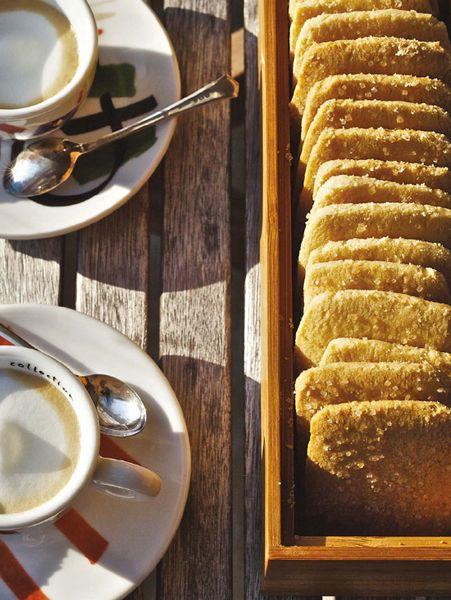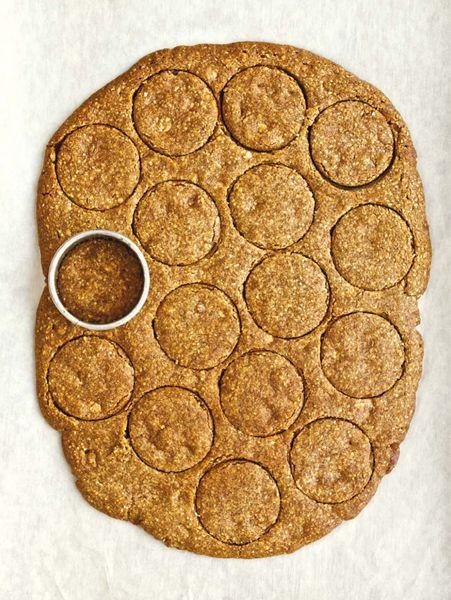Maximum Flavor: Recipes That Will Change the Way You Cook (32 page)
Read Maximum Flavor: Recipes That Will Change the Way You Cook Online
Authors: Aki Kamozawa,H. Alexander Talbot
Tags: #Cooking, #Reference, #Courses & Dishes, #General, #Methods

CRÈME FRAÎCHE CARAMELS
WHEN WE WERE KIDS WE LOVED THOSE LITTLE CELLOPHANE
-wrapped caramels from Kraft. They are the perfect bite and the inspiration for this recipe. We use crème fraîche instead of heavy cream to add a little bit of tang to the finished candies. They are a great blend of chewy and creamy and, yes, we have been known to chop them up and put them into pies like the
Caramel Apple Pie
and substitute fresh, slightly firm peaches for a special summer treat. These caramels are also the perfect texture for folding into cookies and Rice Krispies Treats, or you could just set them out in a bowl and watch them disappear.
MAKES ABOUT 50 (1-INCH / 2.5 CM) PIECES
2 cups 450 grams
crème fraîche
,
homemade or store-bought
1 cup 315 grams
cane syrup
1½ cups packed 320 grams
light brown sugar
1½ cups 300 grams
granulated sugar
8 ounces 225 grams
unsalted butter,
diced
¾ teaspoon 4.5 grams
fine sea salt
Fleur de sel
In a large saucepan, combine the crème fraîche, cane syrup, light brown sugar, granulated sugar, butter, and salt and set over medium heat. Stir until everything is dissolved and then let the mixture cook, without stirring, until it reaches 257°F (125°C) on a candy thermometer.
Meanwhile, butter a 9 × 13-inch (23 × 33 cm) glass baking dish and line the bottom with parchment paper, letting it drape over and line two sides. (You will use the paper to lift the caramel out of the pan.) Butter the parchment paper. Once the caramel reaches 257°F (125°C), pour it into the prepared dish. Let the caramel cool to room temperature for 4 hours and then transfer to the refrigerator for at least 2 hours to firm up.
Use the parchment paper to lift the caramel out of the pan and transfer it to a cutting board. Use a sharp knife to cut the caramel into bite-size pieces and wrap each one in wax paper. Serve with fleur de sel on the side so people can season their own caramels.
COOKING BY DEGREES
Those who take their cooking seriously have a thermometer in their kitchen. These handy kitchen tools take the guesswork out of cooking many foods, especially meats. Thermometers are a must for candy making. Candies are made by cooking sugar to specific temperatures, and, as you may have noticed, caramel is one of our favorite things to make. As the sugar cooks, water evaporates and increases the concentration of sugar in the mixture. The higher the sugar concentration, the harder the finished candy. You can gauge the sugar concentration by the temperature of the sugar mixture, which is why you must have a thermometer to make candy. Frankly, the old candy thermometers drove us crazy. It was almost impossible to get one deep enough into the pan, sugar crystals had an annoying tendency to collect behind it against the side of the pot, and it was hard to read. Now, thanks to modern technology, we can all use probe thermometers. Originally designed with a long cord so that they could be inserted into meats roasting in the oven—with the mechanism safely outside—they are great for cooking sugar. You can check the temperature periodically or clip the slender probe to the side of the pan. We love them, and our caramels—whether they be creamy, chewy, or crunchy—have never been better.
Another place where temperature is incredibly important is egg cookery. People have very strong feelings about the doneness of their eggs, and there are many different dessert recipes where the possibility of an overcooked scramble is a very bad thing. The coagulation temperature of eggs is 185°F (85°C), so most internal cooking temperatures for custards fall well below that. Crème anglaise is perfectly cooked at 179°F (82°C). Baked custards are done between 170° and 175°F (77° and 79°C) to allow for carry over cooking. Soufflés need a double-check, because they have two different textures: soft and tender on the inside and firmer as you move towards the crust. They need to register 150°F (65°C) at the center and 160°F (71°C) about an inch (2.5 cm) from the surface. The internal temperature for cooking any soft meringue is also 160°F (71°C).
You’ll notice that we have a penchant for toppings. Our
Sourdough Coffee Cake
has a combination of gooey topping and streusel over the top. This makes for an extremely wonderful cake but can create a challenge when it comes to checking doneness. The old trick of touching the top to check for firmness will not work here. Instead, we reach for our thermometer again. Sliding the probe into the center of the cake is as easy as using an old-fashioned cake tester and much more accurate. The cake is done when the internal temperature registers 208°–210°F (97°–98°C). This is the maximum range of temperature for all cake types, whether a layer, loaf, pound, chiffon, or sponge. If your temperature has risen much above this limit, you have an overbaked cake that’s likely dry with a thick outside crust and will shrink somewhat as it cools. We like to pull layer cakes at 190°–195°F (87°–90°C) to ensure a moist, tender crumb. Cheesecakes are done when their internal temperature reaches 150°F (65.5°C). Breads have a slightly different range. For soft breads with a tender crumb like brioche or rye, we look for an internal temperature of 190°–200°F (88°–93°C) and for drier, crustier loaves like baguettes or ciabatta we need a temperature of 200°– 210°F (93°–98°C).
Here’s a quick guide to candy temperatures.
CANDY COOKING TEMPERATURES
TEMPERATURE:
230°–235°F / 106°–112°C
STAGE:
THREAD STAGE
DESCRIPTION:
a glaze, a syrup, or caramel sauce
TEMPERATURE:
235°–240°F /112°–116°C
STAGE:
SOFT BALL
DESCRIPTION:
fudge, fondants, creams, and other softly textured candies
TEMPERATURE:
245°–250°F /118°–120°C
STAGE:
FIRM BALL
DESCRIPTION:
soft, chewy caramels and divinity
TEMPERATURE:
255°–265°F /121°–130°C
STAGE:
HARD BALL
DESCRIPTION:
marshmallows, taffy, and other pliable but firm candies
TEMPERATURE:
270°–290°F / 132°–143°C
STAGE:
SOFT CRACK
DESCRIPTION:
toffee, butterscotch, and other candies that gently shatter under your teeth
TEMPERATURE:
300°–310°F / 149°–154°C
STAGE:
HARD CRACK
DESCRIPTION:
brittles, lollipops, and other hard candies

BORDEAUX-STYLE COOKIES
PEPPERIDGE FARM BORDEAUX COOKIES ARE ADDICTIVE. THEY
have this incredibly crisp, light texture and a haunting caramel flavor that stays with you for days. One day, we decided to try and figure out how to re-create them. These cookies, while not exactly the same, are in our humble opinion even better. They have that addictive crisp caramelized flavor that sneaks up on you as you eat them. Somehow they seem to get better with every bite. They’re like the French, or maybe American, version of biscotti, perfect with your morning coffee.
MAKES ABOUT 3 DOZEN COOKIES
8 tablespoons 113 grams
unsalted butter,
at room temperature
1 teaspoon 6 grams
fine sea salt
1 teaspoon 5 grams
baking soda
1½ cups 300 grams
sugar
2 large
eggs,
at room temperature
¼ teaspoon 1 gram
vanilla extract
½ cup 113 grams
rice bran oil
or canola oil
3 cups 450 grams
all-purpose flour
¼ cup 65 grams
whole milk
Raw sugar,
for dusting
In a stand mixer fitted with the paddle attachment, mix the butter, salt, and baking soda on low speed. With the mixer running, add the sugar a little bit at a time. Once all the sugar has been added, turn the mixer up to medium and beat for 30 seconds until light and fluffy. Add the eggs, one at a time, and mix on medium-low until they are fully incorporated into the butter. Add the vanilla and oil and mix on medium-low until it becomes a homogeneous mixture. Add the flour and mix until just blended. Turn the dough out onto a counter and divide it in half. Roll each half into a log or shape it into a long rectangle, wrap in plastic wrap, and chill in the refrigerator until firm, at least 6 hours.
Preheat the oven to 300°F (150°C). Line 2 baking sheets with parchment paper.
Slice each log into pieces ¼ inch (6 mm) thick and lay them on the baking sheets, leaving about ½ inch (1 cm) space between each cookie. Brush the tops of the cookies with the milk and sprinkle raw sugar over them. Bake for 10 minutes and rotate the pans from front to back and switch the racks from top to bottom. Bake until the cookies are a deep golden brown, 5 to 8 more minutes. Transfer the cookies to a wire rack and let cool completely. The cookies will keep in an airtight container for up to 2 weeks.
TOFFEE OATMEAL COOKIES
THESE COOKIES ARE A TRIBUTE TO LINDEN’S BUTTER CRUNCH
cookies. The buttery caramel bits melt as the cookies bake, creating little pockets of chewy, candied goodness. An oatmeal dough adds some heft and flavor and balances the sweetness of the candy. Unlike the original, these are soft chewy cookies that are impossible to keep in the cookie jar.
MAKES ABOUT 3 DOZEN COOKIES
TOFFEE
½ cup 100 grams
sugar
½ teaspoon 3 grams
fine sea salt
4 tablespoons 56 grams
unsalted butter
COOKIE DOUGH
8 ounces 226 grams
unsalted butter
1½ cups packed 320 grams
light brown sugar
1 teaspoon 5 grams
baking soda
1 teaspoon 6 grams
fine sea salt
2 large
eggs,
at room temperature
2¾ cups 412.5 grams
all-purpose flour
2¼ cups 225 grams
rolled oats
MAKE THE TOFFEE:
Line a baking sheet with foil and butter the foil.
In a small heavy-bottomed saucepan, combine the sugar and salt, set over medium-low heat, and cook undisturbed until the sugar is caramelized and a dark mahogany in color, 5 to 8 minutes.
Remove the pan from the heat. Let the hot sugar rest for 30 seconds and then slowly add the butter, swirling it into the hot sugar until it is absorbed. Pour the toffee out onto the prepared baking sheet and let cool. Once the toffee is cold, break it into small chips and reserve in a zip-top bag. The toffee will keep for up to 2 weeks.
MAKE THE COOKIE DOUGH:
In a mixing bowl, with an electric hand mixer, beat the butter, brown sugar, baking soda, and salt until light and fluffy. Add the eggs one at a time, mixing well after each addition. Add the flour and oats and mix slowly to just combine. Fold in the toffee chips. Cover the bowl and refrigerate for at least 3 hours until firm.
Preheat the oven to 375°F (190°C). Line 2 baking sheets with parchment paper.
Use a ¾-ounce (21-gram) scoop to portion the cookies or measure out 1½-tablespoon balls and lay them on the baking sheets, leaving about 2½ inches (5 cm) of space between each cookie. Bake for 8 minutes, then rotate the baking sheets from front to back and switch racks from top to bottom, and cook until the centers are set and the cookies are golden brown around the edges, 4 to 5 minutes more. Transfer the cookies to a wire rack and let cool completely. The cookies will keep in an airtight container for up to 5 days.

